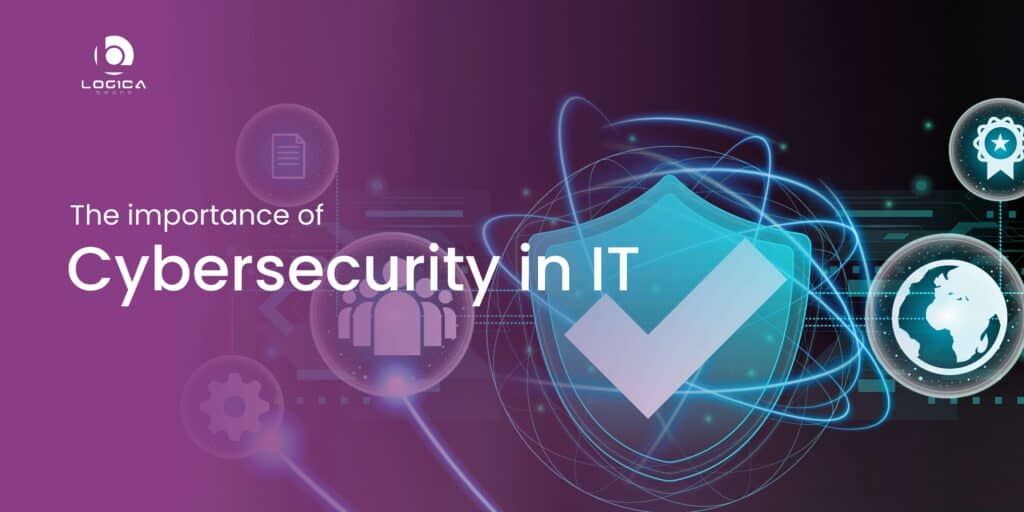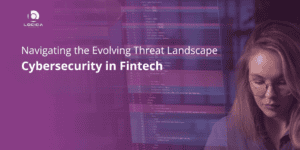Technology has ingrained itself into every aspect of our lives in the linked world of today. Every aspect of our life, from daily activities to commercial operations, is now easier and more convenient thanks to the internet. Cybersecurity dangers are a big risk that come along with this convenience. Cybersecurity in IT industry must be given top priority as hackers’ attacks become more sophisticated with the development of technology.
The significance of cybersecurity in IT industry and the precautions that organizations may take to safeguard themselves against potential cyber-attacks will be covered in this blog. Understanding the significance of cybersecurity is essential for ensuring that everyone has a safer and more secure digital experience, regardless of whether you’re an IT specialist or just an everyday computer user.
The integrity and confidentiality of sensitive data must also be maintained, which is a critical component of cybersecurity. Companies are ideal targets for hackers because they retain a lot of sensitive data, including trade secrets, financial information, and personal customer information. A single breach might have catastrophic results, resulting in a loss of income and client confidence. Businesses may defend themselves and their clients from the damaging effects of cyber-attacks by putting in place strong cybersecurity measures, assuring ongoing operations and long-term success.
Overview of cybersecurity in IT industry
Business are more dependent on digital systems as technology is evolving rapidly, making cybersecurity a primary concern in the IT industry. The activity of defending digital systems, networks, and sensitive data from unwanted access or cyber-attacks is referred as cyber security.
Although certain aspects of cybersecurity are built to prepare for an attack right away, most experts nowadays concentrate more on figuring out how to safeguard all assets, from computers and cellphones to networks and databases, against attacks. Effective cybersecurity in IT industry is considered very crucial as cyberattacks can cause large financial losses, and also harm to one’s brand reputation.
Businesses can protect their digital assets and lessen the risk of cyber-attacks by implementing best practices which includes including frequent vulnerability assessments, staff training and education, and the installation of security software and firewalls. Maintaining the integrity and confidentiality of sensitive information is one of the fundamental reasons why cybersecurity in IT industry is considered important.
Companies in the IT sector are great targets for cybercriminals because they own enormous volumes of private data, including financial information, trade secrets, and consumer data. A single cybersecurity breach can result in large losses, which have an effect on the company’s finances and reputation. Businesses can safeguard themselves and their clients from the damaging effects of cyberthreats by putting a high priority on cybersecurity, assuring ongoing operations and long-term success.
Importance of cybersecurity
The incidence and seriousness of cybercrimes have increased as the technology has become more and more ingrained in human life. For instance, ransomware is a sort of cyberattack that locks the data of the person or an organization until it demands, such as extorted payments, are satisfied. Organizations in the financial, healthcare, and educational sectors have been impacted by these kinds of assaults, which have resulted in major delays and data exposures.
Cybersecurity is still crucial for foreseeing, responding to, and evaluating intrusions. To protect our most private data and conversations, experts in this sector investigate breaches and harmful activities.
Here’s why cybersecurity in IT industry is very much essential:
● Protection against cyberattacks
Cyberattacks can be as basic as email phishing scams or as complex as hackers that take advantage of flaws in software or network architecture. Cybersecurity solutions including firewalls, antivirus software, intrusion detection systems, and encryption are essential to thwart unwanted access and lessen the harm brought on by cyberattacks. Data theft, corrupted systems, and harm to the company’s brand can all arise from failing to safeguard against cyber assaults.
● Regulation compliance
There are rules on cybersecurity in IT industry that apply to many businesses. Healthcare providers, for instance, are required to abide by HIPAA rules that control the security and privacy of patient data, while financial institutions are required to abide by the Payment Card Industry Data Security Standard (PCI DSS), which mandates the protection of customer payment card information. Failure to abide by these rules may result in penalties, legal action, and reputational damage.
● Preserving client trust
Clients anticipate businesses to safeguard their private data from loss or illegal access. Customer data breaches that impair cybersecurity can result in loss of confidence, reputational harm, and economic decline. Businesses may gain and keep customers’ trust by prioritizing cybersecurity and being transparent about their efforts to secure client data.
● Keeping operations running smoothly
Cyberattacks may stop businesses in their tracks and create substantial downtime, which costs them money and productivity. To guarantee that operations can continue in the case of an attack or other disruptive incident, cybersecurity measures including disaster recovery plans and business continuity planning are required.
● Protecting intellectual property
For many businesses, intellectual property including trade secrets, patents, and proprietary software is a significant asset. Cybersecurity measures are required to guard against information theft or illegal access, which might be utilized to provide the organization a competitive edge or suffer financial loss.
● Defending against insider threats
Employees or contractors who have access to confidential information are examples of insider risks that can seriously jeopardize cybersecurity. To prevent unauthorized access and defend against malevolent insiders who could try to steal or harm corporate data, businesses must install cybersecurity measures including access restrictions, monitoring, and training.
● Innovation and competitive advantage
Keeping up with the competition in today’s chaotic and fiercely competitive corporate world requires constant innovation. By safeguarding the sensitive information and intellectual property that businesses need to create novel goods and services, cybersecurity plays a crucial part in fostering innovation. Companies may keep a competitive edge and innovate without concern for theft or compromise by protecting this information.
Moreover, as a condition of doing business, consumers and partners want businesses to exhibit strong cybersecurity in IT industry. Businesses that invest in cybersecurity may set themselves apart from their rivals and get a competitive edge by showcasing their dedication to safeguarding client information and upholding strict security requirements.
Threats to cybersecurity in IT industry
Threats to cybersecurity can broadly be categorized into several types. Here is an overview of some of the most common cybersecurity threats in IT:
● Malware
Malware, sometimes known as “malicious software,” is a category of software created with the intention of harming a computer system, usually by stealing data or seizing control. Malware may appear as viruses, worms, Trojan horses, and ransomware, among other things. Malware may spread via a number of channels, including rogue websites, software downloads, and email attachments. Some common types of malwares are as follows:
●Ransomware: A encryption key that is only known to the attacker is used by ransomware to encrypt files on an infected computer. As payment for the encryption key required to decrypt the victim’s data, the ransomware operator subsequently demands the victim pay a ransom. One of the most costly and conspicuous cyber risks that businesses now face is ransomware, which has recently gained popularity.
●Trojan horse: Trojan horse malware impersonates other things, such as a free trial of priceless software. The malware starts to operate maliciously on the victim’s computer as soon as they download and launch it.
●Remote access trojan (RAT): A particular class of trojan called RATs is intended to act as an entry point for subsequent attacks. The virus gives the attacker remote access and control once it has taken over the victim machine, allowing them to steal sensitive information, download further software, and do other acts.
●Spyware: Spyware is a type of malware that is intended to track and gather data about a computer’s user. User passwords, financial information, and other private and possibly important information may be stolen via spyware so that the attacker may sell it or use it in further assaults.
●Cryptojacking: Bitcoin and other Proof of Work (PoW) cryptocurrencies employ mining, a computationally intensive process, to add new blocks to the network. A system that has been infected with cryptojacking malware will carry out mining activities, using the victim’s processing power to produce blocks and gain money for the attacker.
● Social engineering attack
Social engineering attacks utilize psychological deception to persuade targets into disclosing private information or acting against their better judgment. Phishing, pretexting, and baiting are a few of the several types of social engineering assaults that may be used. Common social engineering attacks include the following examples:
●Phishing: Phishing scams, one of the most common forms of social engineering assault, are email and text message campaigns designed to make victims feel rushed, curious, or afraid. Next it prompts people to divulge private information, click on links to nefarious websites, or open attachments that are infected with malware.
●Spear Phishing: This is a more deliberate phishing scam in which the attacker chooses particular people or companies to target. Next, in order to lessen the visibility of their attack, they modify their communications in accordance with the traits, positions held, and contacts of their victims. Spear phishing is far more labor-intensive and might take weeks or months to execute on the part of the culprit. If done expertly, they’re considerably tougher to find and have higher success rates.
●Baiting: As the term suggests, baiting assaults utilize a fictitious promise to spark a victim’s interest or sense of avarice. In order to steal their personal information or infect their computers with malware, they trick people into falling for a trap. Out of curiosity, the victims pick up the bait and place it into their home or office computer, which causes the system to automatically download malware.
●Scareware: Scareware exposes victims to a barrage of fabricated dangers and false warnings. Users are tricked into believing their computer is infected with malware, which leads them to install software that is either malware itself or has no purpose other than to enrich the offender. Scareware is also known as fraudware, deception software, and rogue scanning software.
● Web application attack
Web application attack are a form of threat in cyber vandalism threat in which hackers use code flaws to obtain access to a server or database. Users have faith that your website will protect and keep private the sensitive personal information they provide there. Some of the common types of web application attacks are given down below:
●Cross-site scripting (XSS): This includes an attacker downloading some malicious script code to your website, which can subsequently be used to steal information or cause various types of harm. Even while this tactic is not particularly advanced, it is nonetheless highly popular and has a big impact.
●SQL Injection: When malicious code is entered into an input form by a hacker, this occurs. If your systems don’t properly clear this data, it might be entered into the database and change, delete, or divulge data to the attacker.
●Local file inclusion: In this rather unusual attack method, a file that is present elsewhere on the system is made to run through the web application.
●Distributed denial of service attacks (DDoS): When a server is overloaded by an attacker, such harmful occurrences take place. In many instances, hackers carry out this attack via a network of hacked machines or automated programs. Such acts render your server inoperable and stop reputable customers from using your services.
Best practice of cybersecurity in IT industry
As a result of the continual evolution of cyber threats in today’s environment, IT industry face an ongoing, dynamic struggle with cybersecurity. Thus, it is essential for IT companies to put best practices into place to safeguard themselves against future cyber-attacks. The finest practices of cybersecurity are given down below:
● Employee training and education
Employee education on best practices of cybersecurity is one of the most efficient methods to avoid cybersecurity breaches. This entails holding consistent training sessions and raising people’s awareness of potential dangers. Workers have to receive training on email phishing, password management, and other typical attack techniques.
● Implementation of security policies and protocols
The execution of security rules and protocols is a further crucial component of cybersecurity. This entails putting in place multi-factor authentication, updating software often, and limiting access to critical data. Also, it’s critical to check the security and up-to-date of any device linked to the corporate network.
● Regular vulnerability assessments and security audits
Businesses can find possible vulnerabilities in their systems and networks by conducting regular vulnerability assessments and security audits. As part of this, networks are scanned for any flaws, potential malware is identified, and security mechanisms are tested to make sure they are functioning properly.
● Installation of security software and firewalls
In the IT business, installing firewalls and security software is a crucial component of cybersecurity. Firewalls, anti-virus software, and anti-malware software fall under this category. These solutions can add an additional layer of protection to the company’s network and assist in defending against future cyber-attacks.
● Data backup and disaster recovery planning
The fundamental cybersecurity in IT industry’s best practices include data backup and disaster recovery preparation. Having a data backup strategy in place may help firms swiftly recover from any data loss in the case of a cyber-attack. A contingency plan for system or network failure is a component of disaster recovery planning.
Conclusion
As a professional in the field, you must put cybersecurity first in order to safeguard your business, your coworkers, and yourself from potential online dangers. You may protect your digital assets and lessen the risk of cyberattacks by putting best practices into operation, such as routine vulnerability assessments, personnel training and education, and the installation of security software and firewalls.










